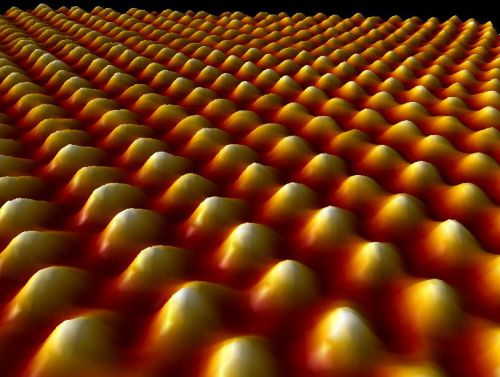Week 8 | Nanotechnology + Art
In this week's lecture, nanotechnology, defined as the the scale of science done at an extremely small perspective, was a concept that was recently incorporated into many different aspects such as chemistry, medicine, biology, and even into common items in the consumer market. Dr. Gimzewski's lecture not only helped me understand the integration between nanotechnology and art, but also helped me visualize how nanotechnology evolved within the artistic aspect (Gimzewski).
 |
| Common Nanoparticles (Figure 2) |
 |
| Image of an Atom, Taken by Scanning Tunnel Microscopy (STM) |
An example mentioned in lecture that helped me further understand was the scanning tunneling microscope ("Meet...Microscopes"). This microscope uncovered a world that was unknown prior. With this probe tip, more discoveries, such as imaging of atoms, new elements, and experiments were showcased (Tersoff).
With nanotechnology bringing forth so much possibilities, a question rises: what's the future of medicine like? In retrospect to the lectures, nanomedicine was a promised potential as it appeared to be a noninvasive method of curing diseases (Nanomedicine). Nanomedicine sparked my interest because of the fact that specific treatments can be target specific, meaning they'd only affect certain cells rather than destroying both good and bad (Ali). However, further testing will need to be done before anything can be officially administered.
Admittedly, nanotechnology is still a fairly new topic for me, but its potentials for medicine was enough to spark my interest into doing more outside research on the topic. In one of the lectures, it was mentioned that nanotechnology could contribute to overall art as it contributes to the environment, reduces dangers in various areas, and is within a small scale. However, before we can determine that, we'd also have to look at the cons, as the small elements can eventually add up, causing harm. Therefore, like aforementioned, more researched should be looked upon.
Word Count: 283
Sources:
[1] Ali, I., et al. “Advances in Nano Drugs for Cancer Chemotherapy.” Current Cancer Drug Targets, vol. 11, no. 2, Feb. 2011, pp. 135–46.
[2] “Figure 2. Schematic Representation of the Most Commonly Used...” ResearchGate, https://www.researchgate.net/figure/Schematic-representation-of-the-most-commonly-used-nanomedicine-types-composed-of_fig2_313022151.
[3] Gimzweski. Vesna, Victoria. "Nanotech for Artists, part 4". DESMA9. 16 May 2022. University of California Los Angeles. Lecture.
[4] “Meet One of the Most Powerful Microscopes.” ThoughtCo, https://www.thoughtco.com/scanning-tunneling-microscope-4075527.
[5] Nanomedicine - Overview. https://commonfund.nih.gov/nanomedicine/overview.
[6] STM-Image-of-Atoms.Jpg https://www.nanoscience.com/wp-content/uploads/2018/05/STM-image-of-atoms.jpg.
[7] Tersoff, J., and D. R. Hamann. “Theory of the Scanning Tunneling Microscope.” Physical Review B, vol. 31, no. 2, Jan. 1985, pp. 805–13. APS, https://doi.org/10.1103/PhysRevB.31.805.
[8] The ScienceVerse. How Nanotechnology Is Changing Medicine. 2020. YouTube, https://www.youtube.com/watch?v=VGFQIkEykxs.
Hi Michelle,
ReplyDeleteI thought it was a really good point to emphasize the connects between nano technology and medicine. I think that being able to target a specific part of a problem cell instead of trying to destroy the cell entirely will be the next big step in science history. I feel like for so long we have been exploring the macro and micro with little concern for the nano which makes up matter in general.